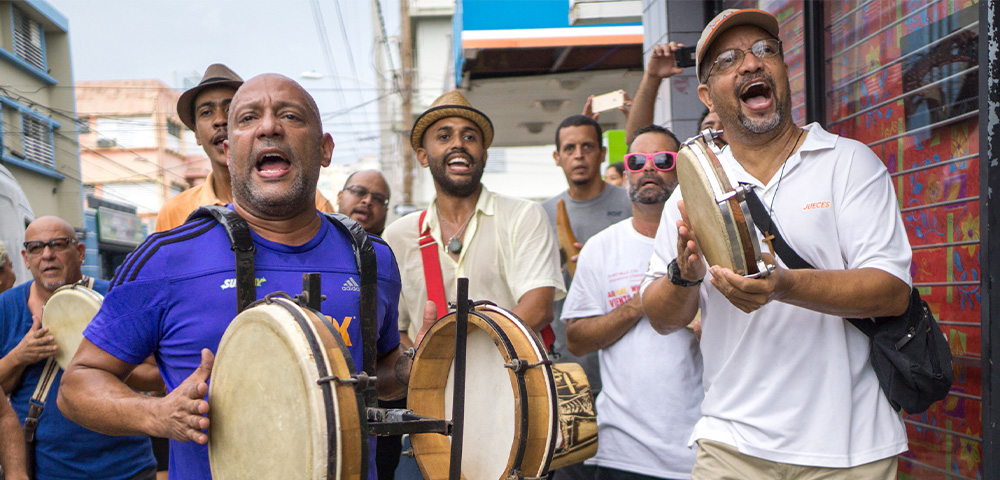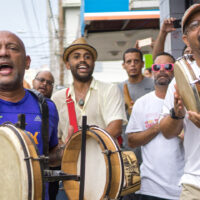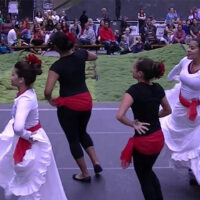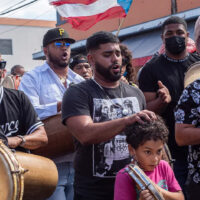
Plena in Puerto Rico
Rhythm, Tradition, and Culture

La plena is more than just a musical genre in Puerto Rico; it is a living embodiment of the island’s soul. Known as “la música del pueblo” (the music of the people), plena is a vibrant and essential expression of Puerto Rican identity, rich with history, rhythm, and culture. Rooted in the Afro-descendant communities of Puerto Rico, it was born in the late 19th century as a way for everyday people to tell their stories, celebrate life, and address social issues through music.
Fusing African, Spanish, and Taíno influences, plena developed into a powerful cultural vehicle that connected generations and communities. Its infectious rhythms and meaningful lyrics reflect the island’s social, political, and emotional landscape. Today, plena is still very much alive, celebrated across the island in festivals, parrandas, and family gatherings.
The genre has not only survived but evolved, influencing contemporary Puerto Rican music and reaching global audiences, all while maintaining its deep roots in the everyday life and struggles of Puerto Rican people.
Origins of La Plena
La plena emerged in the late 1800s in Puerto Rico’s Afro-descendant communities, particularly in the southern and central regions of the island. As a fusion of African, Spanish, and indigenous Taíno influences, it quickly became a distinct form of music that reflected the lives and struggles of the island’s working-class communities.
Unlike many other traditional music genres, la plena is primarily focused on rhythm, and its lyrics often provide commentary on social, political, and cultural issues. The genre’s earliest performances were typically informal, performed during street festivals, community events, and local celebrations. Over time, the music gained in complexity, with the addition of new instruments, and it became a central part of Puerto Rican culture, particularly during major holidays like Christmas and various religious and civic celebrations.
The Sound of La Plena
At its core, la plena is all about rhythm. It’s the beat that drives the music and connects it to the soul of Puerto Rican culture. The typical instruments used in la plena music include the pandero (a type of tambourine), güiro (a scraper), and maracas (shakers). The pandero provides the primary rhythm, often played by hand, while the güiro, scraped with a stick, adds texture and syncopation. The maracas add a bright, percussive layer that enhances the music’s festive, lively character.
The lyrics of a la plena song are equally important. They are often narrative in style, telling stories about everyday life, societal issues, or celebrations. La Plena songs can be joyful, recounting good times and love, or they can be serious, addressing political struggles, economic hardships, or historical events. This ability to blend joyful celebration with powerful social commentary makes plena a unique and dynamic form of expression.
La Plena as a Cultural Expression
Beyond the music itself, la plena serves as a reflection of Puerto Rican culture. It is a form of storytelling that chronicles both personal and collective experiences. Historically, la plena served as an oral record of the community, allowing people to share news, tell stories, and express emotions in ways that connected them to their heritage and each other.
The lyrics of la plena have often addressed issues of poverty, social justice, and political struggle, making it an important tool for social commentary. During times of political unrest, la plena became a means for marginalized voices to be heard. It provided a medium for expressing resistance to colonialism and oppression, and in doing so, became a vehicle for preserving Puerto Rican identity and autonomy.
The Dance of La Plena
Equally important to the music of la plena is its dance. The energetic, expressive movements of dancers capture the celebratory nature of the music. The dance involves swift footwork, hip movements, and the joyful interaction between the dancers and the rhythm of the music. Plena dances are performed in both social settings, like festivals and parrandas, and in formal performances, where trained dancers may incorporate choreographed routines.
The communal nature of the dance allows for participation by people of all ages and backgrounds. The inclusive and participatory nature of both the music and the dance is central to the tradition of la plena, making it a unifying force within Puerto Rican culture.
Festivals and Celebrations
La Plena is celebrated in various festivals throughout Puerto Rico, where it is performed in public squares, parks, and concert halls. The Festival de la Plena is one of the most significant events dedicated to this genre, bringing together musicians, dancers, and fans of the genre from across Puerto Rico and beyond. This festival honors the traditional roots of la plena, while also celebrating its evolution and contemporary interpretations.
During the Christmas season, la plena comes to life in the form of parrandas, where groups of musicians visit homes and public spaces, performing la plena music as part of the island’s Christmas celebrations. These parrandas, or caroling parties, are a beloved tradition, where the music of la plena spreads joy and fosters a sense of community and togetherness.
The Global Influence of La Plena
In recent decades, la plena has not only remained a central part of Puerto Rican culture but has also spread beyond the island. The genre has gained international recognition and has been incorporated into global music scenes, influencing artists worldwide. Contemporary musicians have found ways to blend la plena with other genres such as salsa, jazz, and reggaeton, introducing new generations to the music while preserving its cultural essence.
Through collaborations, global performances, and the increasing popularity of Latin music worldwide, la plena has crossed borders, showing that its rhythmic vitality and compelling storytelling resonate far beyond Puerto Rico. As it continues to evolve, la plena remains a testament to the island’s cultural richness and resilience.
The Enduring Legacy of La Plena
Today, plena remains an essential part of Puerto Rican cultural life. It is celebrated at festivals, community events, and family gatherings, where it continues to bring people together in joyous celebration. Musicians, cultural groups, and institutions continue to preserve and promote la plena, ensuring its place in the cultural landscape for future generations.
As an art form, la plena transcends mere entertainment. It is a vital cultural legacy that celebrates Puerto Rican identity, community, and history. The genre’s infectious rhythms, meaningful lyrics, and vibrant performances continue to remind Puerto Ricans of their collective resilience, pride, and joy. Whether through modern adaptations or traditional performances, la plena remains a living, evolving symbol of Puerto Rican culture—its past, its present, and its future.
La Plena is a powerful and multifaceted cultural expression that captures the essence of Puerto Rican life. Through its rhythms, narratives, and communal celebrations, it continues to thrive as both a form of entertainment and an important means of preserving and transmitting Puerto Rican culture. As Puerto Rico’s “music of the people,” la plena remains a vital symbol of the island’s heritage and a testament to the enduring strength and unity of its people.










